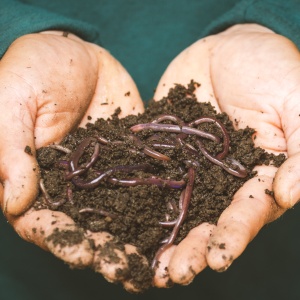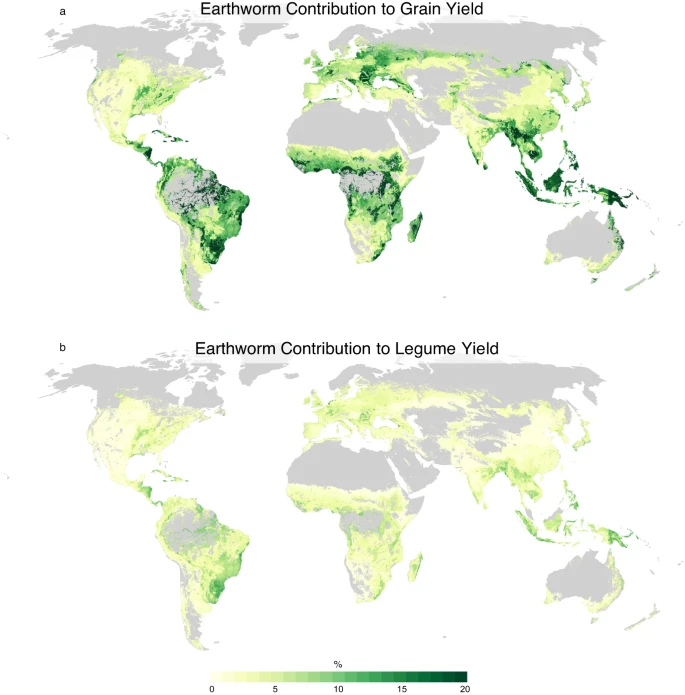
Improving soil health and soil biological communities through agroecological management approaches will be essential for mitigating the environmental impacts of agricultural intensification in the future. In order to demonstrate some of the values of agroecological practices, this meta-analysis estimates the value of soil biological communities through the earthworms impact on the productivity of global cereal and legume crops.
Summary
Earthworms are important ecosystem engineers, positively impacting soil structure, water capture, organic matter cycling and nutrient availability, as well as facilitating the production of plant growth-promoting hormones. As a result, earthworms significantly improve crop growth, but their overall contribution to agricultural production is poorly understood. This paper estimates the impact on the productivity of major cereal and legume crops using mean effect sizes from a meta-analysis that reported varying earthworm-yield responses for different crop types, soil properties and N fertiliser inputs. These values were combined with a map of the distribution and abundance of earthworms and global soil management, and crop data to estimate their total impact. The estimates suggest that earthworms contribute around 5% of global production for the major cereal and legume crops. When separated the impact of cereals is almost 6.5% and the impact on legumes 2.3%, likely due to legumes’ capacity to fix their own nitrogen, and thus being less dependent on the nutrient recycling effect of earthworm populations.
These results had some regional differentiation due to soil types, fertiliser use and natural abundances of earthworms. The greatest beneficial effect could be seen in Sub-Saharan Africa, where earthworms are estimated to contribute significantly to productivity, accounting for roughly 10% of total cereal production. This was due to lower soil pH, higher clay content and lower fertiliser inputs in Sub-Saharan agricultural systems. Higher impacts in Europe and South-Eastern Asia were also likely due to higher predicted earthworm abundance. A distributed map can be seen in figure 1.

Fonte et. al., 2023; Map of earthworm contribution to Cereal and Legume Yields
The authors note the following uncertainties and limitations:
- Studies of plant response to worms used in the meta-analysis relied on data derived from environments which may contain unrealistic densities of earthworms, thus overestimating the potential earthworm effect on plant growth. This was accounted for by taking abundance into account when calculating the relative earthworm effect,
- Equally, the short term nature of these experiments might not capture the full array of long term benefits on crop growth
- The analysis assumed simple additive effects for the plant and environmental factors that influenced the earthworm benefit, as they were not able to parse out potential interactions between these drivers.
- There was a strong sampling bias towards the global North, with the vast majority of data points coming from Europe and eastern North America
- Finally, while the effect of earthworms is notable, the authors suggest that other soil biota may be equally important, indicating the need for further research.
Abstract
Earthworms are critical soil ecosystem engineers that support plant growth in numerous ways; however, their contribution to global agricultural production has not been quantified. We estimate the impacts of earthworms on global production of key crops by analyzing maps of earthworm abundance, soil properties, and crop yields together with earthworm-yield responses from the literature. Our findings indicate that earthworms contribute to roughly 6.5% of global grain (maize, rice, wheat, barley) production and 2.3% of legume production, equivalent to over 140 million metric tons annually. The earthworm contribution is especially notable in the global South, where earthworms contribute 10% of total grain production in Sub-Saharan Africa and 8% in Latin America and the Caribbean. Our findings suggest that earthworms are important drivers of global food production and that investment in agroecological policies and practices to support earthworm populations and overall soil biodiversity could contribute greatly to sustainable agricultural goals.
Reference
Fonte, S.J., Hsieh, M. and Mueller, N.D., 2023. Earthworms contribute significantly to global food production. Nature Communications, 14(1), p.5713.
Read the article here and read more on agroecology in our explainer







Post a new comment »